
| February 2002 | ||||||
| Sun | Mon | Tue | Wed | Thu | Fri | Sat |
| 1 | 2 | |||||
| 3 | 4 | 5 | 6 | 7 | 8 | 9 |
| 10 | 11 | 12 | 13 | 14 | 15 | 16 |
| 17 | 18 | 19 | 20 | 21 | 22 | 23 |
| 24 | 25 | 26 | 27 | 28 | ||
Monday 11 February 2002
At 1200, EST the Training Ship Empire State was located 13 nautical miles southeast of Guanica, Puerto Rico, 17 degrees and 45 minutes North Latitude and 066 degrees 51 minutes West Longitude, steering course 280 degrees true at a speed of 10 knots/Rpm 48 turns. The weather was clear, winds from the east at 17 to 21 knots, air temperature was 81 degrees Fahrenheit, barometric pressure was 1019 millibars, seas were moderate from the east, sea injection temperature was 78 degrees Fahrenheit. Depth of water beneath the keel was 902 fathoms.
CAPTAIN'S LOG
"Could we see when and where we would meet again, we would be more tender when we bid our friends goodbye." Ouida pseudonym of Marie Louise De La Ramée (1839-1908), English novelist
Ponce, Puerto Rico is now but a portfolio of memories, and all would agree that the fantastic events of the past weekend make them very pleasant ones, indeed. We enjoyed Ponce for a fraction of the market price of such a stop due to the hard work by Captain Jose Rivera, our host from the Caribbean Harbor Pilots Association. He is the senior pilot of Puerto Rico, and as a resident of Ponce, he encourages local businesses and port officials to be generous with visiting schoolships and military vessels. Our pilots, tugs and wharfage were free and the lighthouse and navigation fees were waived. A free jitney van to town was included, as well as a wonderful reception at the Ponce Yacht Club last Friday evening. I want to mention some of the reception sponsors, whose generosity made our port stay much more enjoyable: the Municipio Autonomo de Ponce (City of Ponce), Ecoelectrica (the local electric compamy), AES Puerto Rico, Destileria Serralles Inc., Puerto Rican Cement, Inc., Leevac Marine (a marine towing company, with our own Mike Rommanelli '82), the local NOAA Office, South Puerto Rico Towing, Puerto Rican Operations Inc., Officials of the Guardia Costanera, and the Camara de Comercio de Ponce. Special thanks must go out to Luis A. Ayala Colon, Inc., our agent while in port, particularly to the one who did all the leg work - Mr. Eric Gonzales. Finally, all of us aboard wish fair winds and following seas to Captain Rivera and his lovely wife Pat, who made it all possible. Ponce was a perfect paridise.
The cadets and crew fanned out island wide yesterday, and exhausted themselves touring the sights, taking advantage of a day on the beach, and enjoying the finale of Ponce Carnival; a magnificent seven hour parade that featured hundreds of costumed school children, bands, cheerleaders, and spectacular floats. Some returned early to stoically accept the watch and begin the pre underway checks. However, most pushed the envelope until the very last and then fell into their bunks for short catnaps before the dreaded alarm. Then, there were those who remind me of toddlers fighting the nap. They fear that in sleep, they are sure to miss something... and they just arn't going to let that happen to them. This group shuns rest and chooses instead to crowd the mess deck, talk, and drink black coffee until dawn. They rehash and embellish every minute detail. They cling to every morsel and in so doing create the unwritten history of the Sea Term that will follow them and their classmates into old age. Facts never spoil good sea stories.
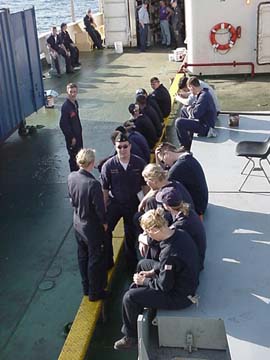
The now familiar checklists were wrinkled and dog-eared when all of the complex guidance and propulsion systems were at last on-line and operating normally. But as the brilliant orange sun peaked through the puffy clouds at sunrise, we were ready and the "dawn" of departure slowly gave way to expectation. At 0831 the Pilot stepped onto the bridge, introduced himself to the watch, and at 0917 we were underway to Port Everglades, Florida; ETA 0800 15 February 2002.
Ponce's Harbor is only a short distance north of the Caribbean and we were soon in deep blue water. At 0943, we wished the Pilot well, turned hard to starboard, and steamed westward toward the Mona Passage. This narrow passage separates the Shining Star of the Caribbean from Hispanolia and connects the Caribbean Sea with the Atlantic Ocean. It is a major shipping channel with the well-earned reputation for unpredictable currents and spiteful seas that dates to the time of Columbus. Situated almost dead center in the Caribbean entrance is tiny Mona Island. It is rumored to have been a pit stop for pirates and that is not surprising. Even today, the Island is a hermit's paradise. Cliffs rise up almost 300 feet from crystal blue waters and provide superb habitat for many species of birds, sea turtles, and big (four feet long) lizards (Iguanas). The Island is uninhabited except for the critters. The weather is nice today, visibility is good and we will tip our hats as we turn north (home is north, north is good) and hustle on by to begin the seventy-mile transit through the straits and into the cooler Atlantic. If you were wondering whether the cadets were happy about going home and pleased with the trip so far... check out these smiles:
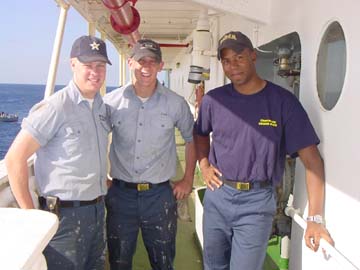
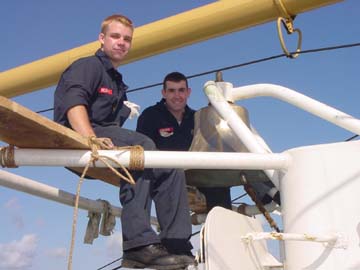
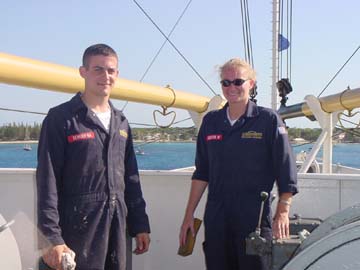
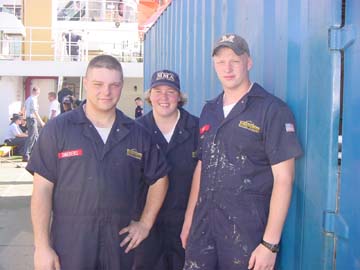
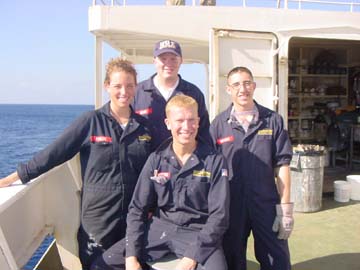
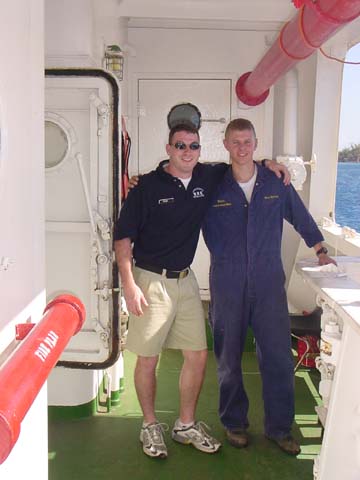
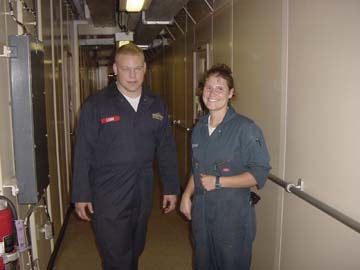
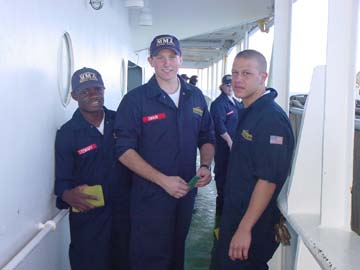
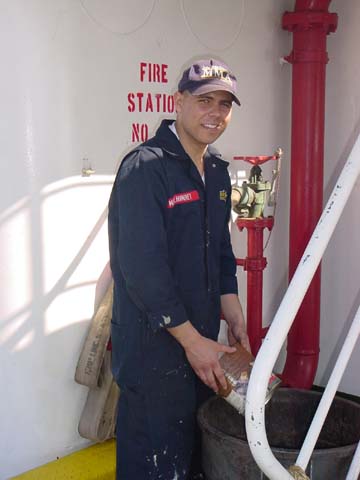
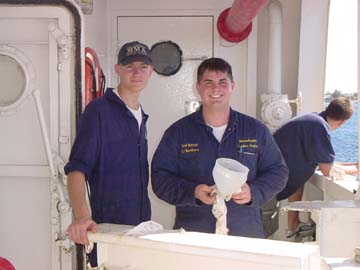
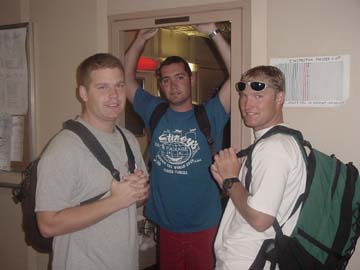
The ocean that we inhabit during the next few days is dotted with hundreds of tiny, and not so tiny, islands with names like Turks, Caicos, Inagua, and Exuma. Their names call forth the memory of adventurous sailors and of sea voyages past but mostly they remind us of the dangers that abound and of a complex navigational picture, which mandates constant attention. The cadets are well prepared to face the challenges. See you tomorrow from somewhat closer to there.
CADET'S COMMENT
Deck Training and Watchstanding, By Cadet 4/C James Horton
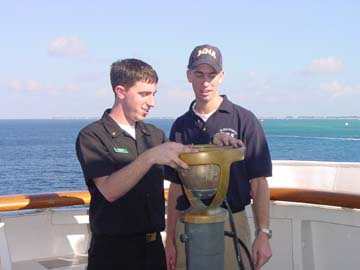
Twenty knots, 25 Miles an hour; Sounds kind of slow, doesn't it? Well, it is, if you were in, say, a little Mercedes darting out of Union Station. That speed would hardly raise an eyebrow. Now imagine something the size of Union Station suddenly following that same car at 25 miles an hour. Not so slow anymore, is it? We are doing 20 knots while I sit here, typing away on the last day of deck watch 2002. I can tell that we are doing 20 knots because I feel as though the ship has become one of those "Magic Fingers" vibrating beds that are advertised on TV. The Empire State hasn't gone this fast in ages.
I must say I LOVE deck watch and for the following simple reasons:
1. I now look like George Hamilton and his Perma-tan from being on deck so much (I looked like Casper when I was on Engine Watch).
2. I come out as clean as when I went in.
3. One word: Sunlight
4. I have never seen as many stars in my life.
5. Fresh air = Good. Fuel Oil fumes = Bad
6. You don't have to scream to be heard by someone three inches away.
7. Driving something as long as the Washington Monument is tall, is way cooler than watching a gauge glass.
I admit it; I wanted to go deck when I first applied to the Academy. Now that I have actual bridge experience, I can easily say that I made the right decision. The past two weeks have been filled with amazing training sessions and watches, all very educational and entertaining. The classes covered an array of topics, from Radar plotting to Rules of the Road. Knots, and how to tie them, are ALWAYS on the menu at Mass Maritime, and unfailingly delivered by the one, the only, Captain Bruce! We completed quite a bit of splicing and knot tying at school, and here, with his help, we spliced, diced, and learned such necessary evils as how to tie a boatswain's chair. Learning to tie the chair was great, especially since the ship was gyrating through 20 degrees of roll and we were hanging from the rafters like piñatas. The Rules of the Road course built upon prior navigation experience gained during a lifetime of sailing (thanks Dad). One section that particularly interested me stated that a sailing vessel has the right of way in most circumstances, even if a ship is confined to a channel, towing, being driven by freshmen, etc. Firefighting was also discussed and especially emphasized since fire is so deadly on a ship. With only one place to go (overboard) and no 911 to dial, we must fend for ourselves when disaster strikes. These classes helped to build on prior experiences at both the Academy and the Barnstable Fire Fighting Academy. We toured the Damage Control (D.C.) Lockers and learned about everything in them. For example, hoses two inches in diameter may be used on the Weather (outer) deck, as there is no concern for flooding. However below, the situation changes below decks; too much water in compartment(s) can adversely affect the stability y of the vessel so smaller one inch hose is used. A compartment flooded by overzealous fire crews can capsize a ship. That happened to the 1,029-foot trans-Atlantic liner Normandy in 1941. A small fire started onboard, and so much water was dumped onto her upper decks that she became top heavy and toppled over at her pier. We are taught to avoid such situations.
Watches are not only educational; they are a wonderful chance to work on my tan. We rotated through the different watch stations; bow and stern watch, lookout watch, messenger on the bridge and detex watches. The Detex watch is a security watch and the watchstander systematically visits many stations (25) throughout the ship. Each station has a key that must be inserted into a detex clock to record the time of the visit. We were trained to look for unsafe conditions, disturbances, cleanliness, and as always, fire. Messenger watch on the bridge is my favorite, as we get to do a myriad of tasks, from steering to helping the sophomores plot new courses. All important decisions inevitably make their way to the bridge, so it is a mecca of information and action, such as rescues at sea. I also learned to plot points on a chart, use the ECDIS (Electronic Chart Display), and check on contacts with the Radar. Bow and stern watch are lookout positions, as are the bridge wing lookouts and I learned to keep my eyes peeled for ships coming over the horizon, debris in the water, or changing atmospheric conditions. Anything unusual is reported to the bridge, where a senior officer takes necessary action. I can truly say that I know what the lookout on the Titanic felt while trying to search for objects in the water with no moon, no wind, or other point of reference. On dark nights, the sky becomes one with the sea, one continuous inky void where danger may lurk. On clear days however, the ocean entertained me with dolphins playing around the bow, flocks of birds keeping pace with the ship, and flying fish jumping all round. (they can indeed fly. Go figure). All in all, I will miss deck watches and classes. They provided me with a great insight into how the bridge and its resources are managed, and demonstrated just how awesome the responsibility of directing the home of 700 people truly is.
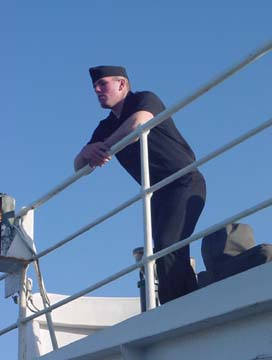
QUESTIONS FOR TUESDAY 12 FEBRUARY 2002
MATH: The average deck cadet watches the radarscope 2.6 hours per day. How many minutes will she watch in one week?
SCIENCE: Mass is the measurement of the matter in an object. The mass per unit volume of a material is __________.
GEOGRAPHY: Geographers are fond of establishing "imaginary lines" on the Earth. They are invisible (you can't see it if you fly over the spot) but they have some meaning. Here's one: What is the name of the imaginary line that marks the farthest North that the rays of the sun fall directly (at 90 degrees) on the Earth? The rays of the sun fall directly on this "line" once a year. When it happens we say it is the first day of summer.
HISTORY: Many African slaves were used on the sugar plantations in the Caribbean. Held under tight control and harshly treated, they nonetheless occasionally revolted against the plantation owners and the system of slavery. On one island Toussaint L'Overature, an African slave, lead a successful uprising in 1804 and established freedom for the black population. What was the name of the island where this happened?
ANSWERS FOR MONDAY 11 FEBRUARY 2002
MATH: Cadet Williams traveled 3 hours so 3 x 50 = 150 miles traveled. 150 divided by 15 (Hansen's speed) = 10 hours. 1100 +10 hours = 2100 or 9:00 PM
SCIENCE: Scientific law, hypothesis, theory.
GEOGRAPHY: The Straits of Florida
HISTORY: The Triangle Trade